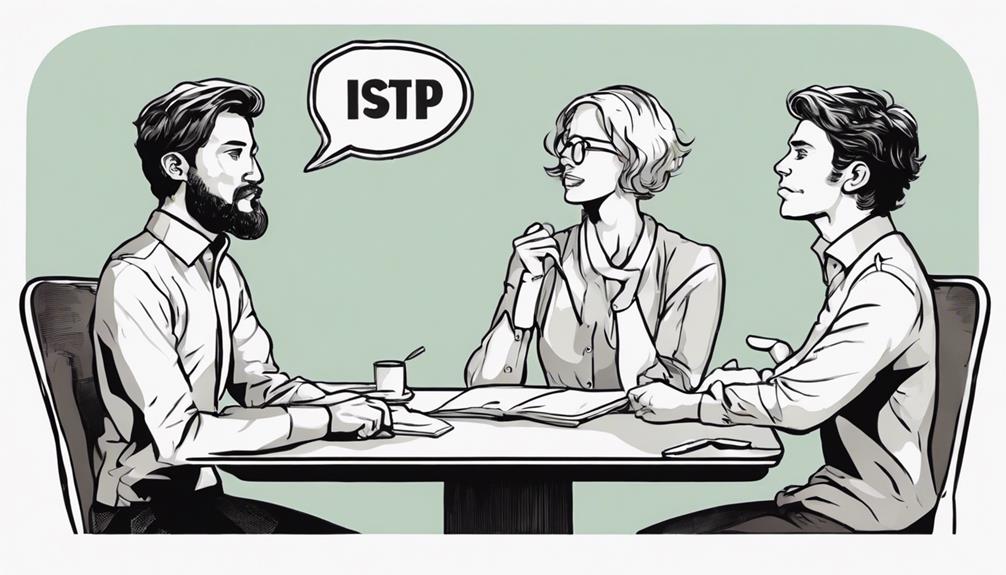As we explore the complex interplay of the ISTP-ESFJ relationship dynamics, it’s like untangling the strands of a tapestry crafted from contrasting colors.
The interplay between the practicality of the ISTP and the emotional depth of the ESFJ sets the stage for a captivating exploration. However, understanding how these contrasting elements can both clash and complement each other lays the groundwork for truly unlocking the potential of this unique relationship dynamic.
The intricate nuances that shape their interactions hold the key to a deeper appreciation of the intricate bond between these two personality types.
Key Takeaways
- ISTPs and ESFJs can complement each other by bridging practicality with emotional intimacy.
- Communication challenges arise from direct vs. indirect styles, requiring empathy and understanding.
- Conflict resolution hinges on clear, direct communication, active listening, and mutual respect.
- Building trust involves open communication, appreciation of differences, and fostering connection through logical and emotional support.
Personality Traits of ISTP and ESFJ
Exploring the contrasting personality traits of ISTP and ESFJ sheds light on the dynamics that shape their relationship.
ISTPs are known for their practicality and logical thinking, often focusing on problem-solving and analysis. They may struggle with expressing emotions openly, which can sometimes pose a challenge in forming a deep emotional connection with their ESFJ partners.
On the other hand, ESFJs are warm, empathetic individuals who excel in social situations and prioritize emotional connection in relationships. Their desire for emotional intimacy contrasts with the more reserved nature of ISTPs. ESFJs value storytelling and anecdotes as a way to connect with others, whereas ISTPs prefer concise and straightforward communication.
Despite these differences, ISTPs and ESFJs have the potential to complement each other well. By understanding and respecting each other's unique traits, they can navigate their emotional differences to build a strong and harmonious relationship based on mutual growth and understanding.
Communication Styles in the Relationship

Understanding the contrasting communication styles between ISTPs and ESFJs is crucial in navigating the dynamics of their relationship. ISTPs tend to communicate concisely and directly, while ESFJs prefer sharing through storytelling and anecdotes, creating a potential mismatch in their interaction styles.
Here are some key points to consider:
- Direct vs. Indirect Communication: ISTPs may find ESFJs' indirect communication challenging, while ESFJs might perceive ISTPs as too blunt.
- Listening vs. Expressing: ISTPs often listen more than they speak, which can lead to misunderstandings with ESFJs who value verbal expression.
- Emotional Impact: ISTPs should be mindful of the emotional impact of their words on ESFJs, considering their focus on harmony and connection.
Navigating these differences can enhance communication in the ISTP-ESFJ relationship, fostering understanding and empathy between the two personalities.
Conflict Resolution Strategies
In navigating conflicts between ISTPs and ESFJs, patience and empathy are essential components for effective resolution. Understanding each other's communication styles is crucial in finding common ground during disagreements. ISTPs tend to communicate concisely, while ESFJs often prefer a storytelling approach. This difference can sometimes lead to misunderstandings, but by approaching conflicts with patience and empathy, both parties can work towards a resolution.
During conflict resolution, it's vital for ISTPs and ESFJs to appreciate and respect each other's perspectives. Clear and direct communication, coupled with active listening, can help bridge the gap between their contrasting styles. ISTPs may need to express themselves more openly, while ESFJs might benefit from focusing on the main points to avoid overwhelming the conversation.
Building Trust and Connection

To establish a strong foundation of trust and connection between ISTPs and ESFJs, prioritizing open communication, mutual appreciation of differences, and active support is paramount.
- Communication: Honest and open communication is key in building trust. ISTPs and ESFJs should express their thoughts, feelings, and needs clearly and respectfully to foster understanding and connection.
- Personal Space: Respecting each other's personal space is crucial for trust to flourish. ISTPs should allow ESFJs the freedom to express their emotions without feeling suffocated, while ESFJs should understand and respect the ISTPs' need for independence.
- Encouragement: Providing encouragement and support is essential in strengthening the bond between ISTPs and ESFJs. ISTPs can offer logical solutions and practical advice, while ESFJs can uplift and motivate with their warmth and kindness. Encouragement builds a sense of security and appreciation in the relationship, fostering trust and connection.
Coping With Differences and Challenges
Navigating the unique blend of differences and challenges in an ISTP-ESFJ relationship requires a delicate balance of adaptation and mutual understanding. Understanding and respecting each other's communication styles is crucial in fostering effective dialogue and preventing misunderstandings. ISTPs and ESFJs can manage conflicts by embracing compromise, patience, and a willingness to listen with an open mind.
Adapting to each other's decision-making processes can help alleviate tension and promote harmony in decision-making. Building trust is fundamental in overcoming differences; this can be achieved through a combination of logical communication and emotional support. By finding common ground and appreciating each other's strengths, ISTPs and ESFJs can create a supportive and fulfilling relationship dynamic.
Embracing these strategies with empathy and openness can strengthen the bond between ISTPs and ESFJs, allowing them to navigate challenges together with resilience and understanding.
Frequently Asked Questions
Do ESFJ and ISTP Get Along?
We totally get along! Our loyalty and commitment create a strong bond. Our differences complement each other – warmth balancing practicality, logic enhancing empathy. Respecting each other leads to a fulfilling and harmonious relationship.
What Is the Personality of ISTP and Esfj?
We're a mix of practicality and warmth. ISTPs dive into problem-solving with logic, while ESFJs excel in building connections. Together, we balance independence and social skills, creating a dynamic blend of hands-on action and emotional depth.
What Is the Best Relationship Type for Istp?
We find that the best relationship type for us ISTPs involves partners who appreciate our independence, logical thinking, and need for alone time. Encouraging personal growth, respecting boundaries, and sharing common interests are crucial.
What Personality Type Is Least Compatible With Istp?
We've found that ESFJs might be the least compatible with us ISTPs. Our different communication styles, decision-making processes, and priorities can create challenges. Understanding and respecting these differences is key to navigating potential compatibility issues.
Conclusion
In the dance of the ISTP-ESFJ relationship, we navigate the intricate steps of logic and empathy, finding harmony in our differences. Like a delicate balance beam, we tip and sway, but with open communication and understanding, we learn to walk together in sync.
Embracing our unique traits and adapting to one another's needs, we create a beautiful bond that withstands the test of time. Let's continue to support and uplift each other on this journey of love and growth.









